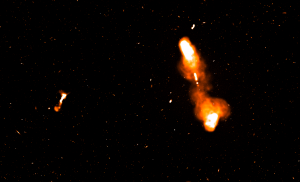International teams complete SKA’s first Science Data Challenge

Nine teams representing 12 institutions in 8 countries took part in the challenge. They were invited to analyse a series of high resolution images of the radio sky created through data simulations, and use software of their choosing to find, identify and classify the sources.
The images show how the SKA’s mid-frequency array, to be located in South Africa, would see the radio sky at three different frequencies (560 MHz, 1.4 GHz and 9.2 GHz), over three different exposure times: eight hours, 100 hours and 1000 hours. Each of the nine images filled 4GBytes (or 1074 MegaPixels).
“I am thrilled at the response to our first Science Data Challenge, and to see the SKA community so engaged – a big thank you to all of those who got involved,” said SKA Project Scientist Dr. Anna Bonaldi, who has been leading work on the challenge. “As we hoped, the teams were made up of not only radio astronomers and members of our Science Working Groups, but also the wider astronomy and computer science communities, showing the broad engagement around the SKA.”
This was the first in what will become a series of challenges aimed at training the SKA community in what to expect from SKA data, and the kinds of approaches needed to make the most of it.
“The Science Data Challenge offered an opportunity to prepare for the types of data the telescope will eventually gather from the sky,” said Professor Andreas Wicenec from the International Centre for Radio Astronomy Research (ICRAR) – the organisation that topped the challenge’s leader boards.
Each team’s findings were ranked according to the number of accurate detections, meaning their software had to distinguish between genuine astronomical objects and image noise – no mean feat when dealing with simulations of extremely faint radio emissions from the distant Universe.
“It was particularly interesting to see the wide variety of approaches taken” Dr. Bonaldi added.
“Some of them are tried-and-tested but others are brand new, so seeing the variety of approaches is extremely valuable in preparing users to deal with real SKA data in the future.”
“In the case of ICRAR, we had two teams participating in the challenge, one of which partnered with the University of Oxford in the UK” said Prof. Wicenec.
“One used a prototype machine-learning algorithm, which was developed to identify and classify extended radio sources, and the other used a technique based on traditional image segmentation analysis.
We’re very pleased with how well both methods performed in identifying extremely faint radio sources hidden in the simulated data, and we’re obviously really happy with ICRAR’s performance overall in this inaugural challenge.”
The SKA Project Science team will now encourage the teams involved to collaborate by sharing their lessons learnt from each approach, with a view to publishing a scientific paper on the challenge.
A full list of the participants, results and ranking methodology can be found on the SKA Science website.




